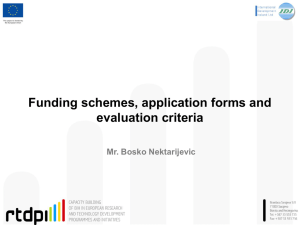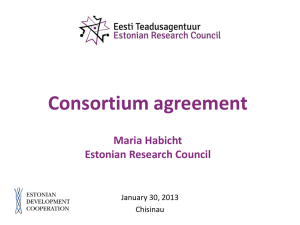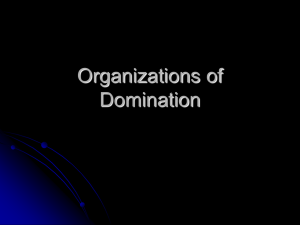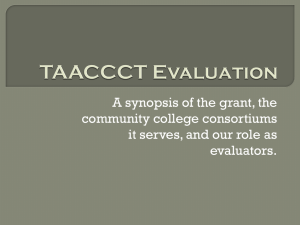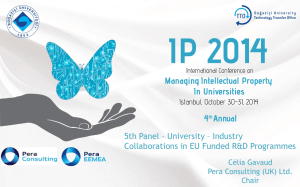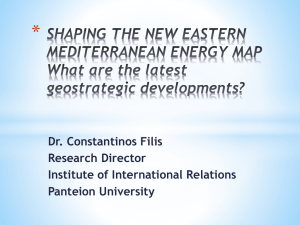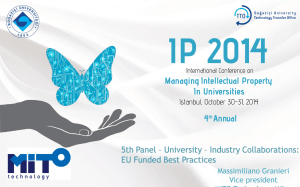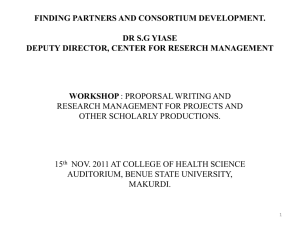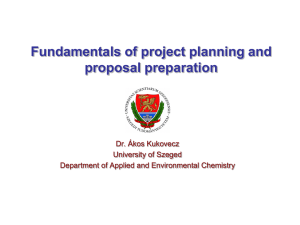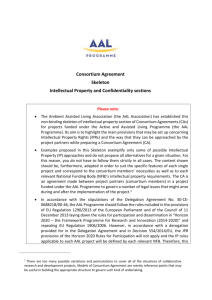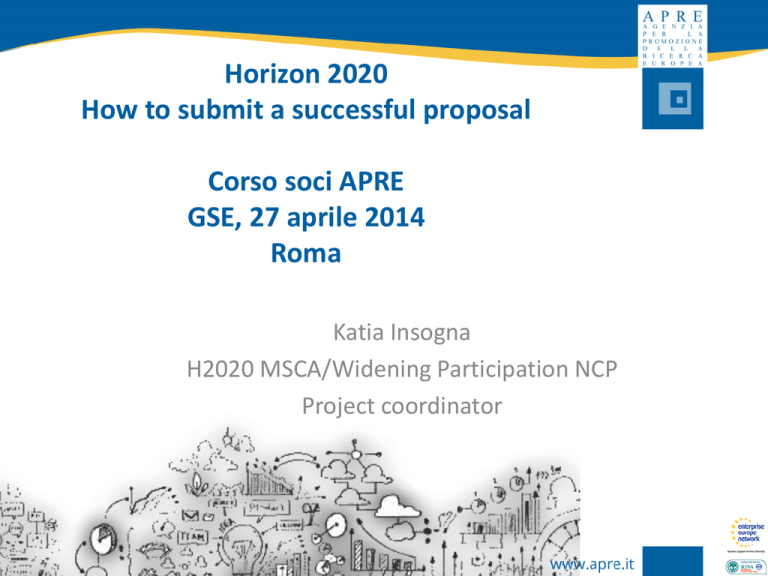
Horizon 2020
How to submit a successful proposal
Corso soci APRE
GSE, 27 aprile 2014
Roma
Katia Insogna
H2020 MSCA/Widening Participation NCP
Project coordinator
Structuring the
project idea
Consortium
building
Submission
Idea
Evaluation & selection
Proposal
synthesis
Negotiation
Payments
exploitation
Consortium
agreement
Final Report &
Cost statement
Contract
Real work & consortium running
ESTIMATION OF EFFORTS
EC SURVEY ON ADMINISTRATIVE COSTS FOR MANAGING FP7 GRANTS
Average time to find a suitable call for proposal: 10 hours but 1 hour (or
less) for experienced participants
Average time to build partnership: 16 hours per partner + meetings (if
relevant) except when continuation of a previous project
Average time coordinators spend to write the proposal: 190 hours,
depending on experience and project size
STARTING
Your
IDEA must be innovative
Patent databases
ex. http://it.espacenet.com
IPR helpdesk
www.ipr-helpdesk.org
Previously funded projects FP7
http://cordis.europa.eu/fp7/projects_en.html
5
Outline idea
Describe on 1/2 page the following
• What is the problem?
• What are the goals?
• What is your innovative solution?
Problem
State of the art
Innovation !
Goal
6
Brainstorming your Idea
What can I OFFER to a European project?
Should I discuss the idea with the NCP/EC?
Do I have the necessary time to prepare the
proposal?
Is the organisation supporting me?
7
Fitting H2020
EU
programmes
H2020
Societal
Challenge
Topic
PROJECT IDEA
8
Structuring a project
WHY? Objectives
HOW? Activities
WHO? Responsabilities
WHERE? Locations
WHAT? Results
WHEN? Planning
9
"Five Ws and One H" problem solving method is also called
as the "Kipling
Method“
Helpful when you need to see the problem from
different perspectives or when you would like to
generate ideas
Useful in the process of selecting ideas for further
development
Give a deeper understanding
10
WHY?
Define the objectives in the European political contest
General Objectives
Long term: beyond the duration of the project
Improve, strenght, facilitate, realize …
Specific Objectives
To be realized during the project implementation
Testing, pilot plant, develop new knowledge, …
General Objectives
Organisations (PU/PRI)
European Union
Enhancement / Profit!
Policies of the Community!
Improving profit
Enhancing innovation
Improving efficiency
Cost reduction
Train the staff
Strengthen the image
Enter new market
generate growth
job creation
protecting the environment
Creating industrial leadership
move towards a low-carbon economy
investing in skills & training
modernising labour markets and welfare
systems
Increase the competitiveness of EU
Translate your own objectives into
the political objectives of the EC
Specific Objectives - SMART
13
Example:
General objectives:
The aim of ESTERPHARMA is development of competitive and eco-friendly
biotechnological routes for production of molecules with pharmacological
(antimicrobial, antiviral, anti-inflammatory and/or antitumour) activity.
Specific objectives:
• Optimizing enzyme production, bringing the production of 4 native and 1
improved fungal feruloyl esterases and 2 native and 1 improved fungal
glucuronoyl esterase from lab scale to fermentation level at 5-20 l scale
with a production level of at least 10 mg/l.
• Developing improved downstream processes and methods for enzyme
formulation and immobilisation: achieving at least 2-fold increase in
conversion yield by using enzymatic cocktails, and developing immobilised
biocatalysts recyclable at least ten times.
• …..
HOW?
Identifying the main activities
Work Breakdown Structure (WBS)
Work Packages (WP)
Tasks (T)
Management basis (monitoring)
• Simplifying the project execution
• Larger tasks are broken down to manageable chunks of
work. These chunks can be easily supervised and estimated.
15
Work Breakdown Structure
Decomposition of a project into smaller components. It defines
and groups a project's discrete work elements in a way that
helps organize and define the total work scope of the project
WBS is developed by starting with the end objective and
successively subdividing it into manageable components in
terms of size, duration and responsibility (e.g. tasks, subtasks
and work packages) which include all steps necessary to achieve
the objective
Work Breakdown Structure
17
WHO?
Principal partners
each partner has a clearly defined role
Link the activities and results to project partners
Complementariety
Different types
Involvement of external stakeholders
Users: Evaluation Committee
Advisory committee (scientific, IPR, gender,
exploitation, etc.)
18
You are only part of the puzzle
Always look for
Balance, Complementarity, Excellence, Commitment
Create your
consortium in line
with the project
objectives
19
Roles in the project
Official roles
Coordinator
Partner
Practical roles
Technology/solution
Developer
End user
Training specialist
Project manager
Dissemination expert
..
WHERE?
Principal partners
Europe and beyond
Topic/Idea based
Best vs Worst place to test the technology (pilot plant)
Object/Objective of the study
21
WHAT?
Main result
Primary goals to realise the project objective
May be composed of multiple smaller deliverables
Detailed results
Intermediary results necessary for the achievement of the
main results (deliverables)
Used for monitoring the project implementation
Tangible or intangible object
Tangible: prototype of platform, software, publications, …
Intangible: new knowledge (in report), proven added value, …
Deliverable
Outcome or output
QUANTIFY E QUALIFY!
22
Milestones
Are control points where decisions are needed with regard to the
next stage of the project
For example, a milestone may occur when a major result has been
achieved, if its successful attainment is required for the next
phase of work.
Another example would be a point when the consortium must
decide which of several technologies to adopt for further
development.
23
Deliverable vs Milestone
A milestone is a measurement of progress toward an output
whereas the deliverable is the result of the process
Milestones can be put before the end of a phase so that corrective actions
can be taken, if problems arise, and the deliverable can be completed on
time
24
WHEN?
Project scheduling
Gantt charts illustrate the start and finish dates of the
terminal elements of a project
Terminal elements comprise the work breakdown structure
of the project
shows you what has to be done (the activities) and when
(the schedule)
25
Gantt Chart
1.
2.
3.
4.
5.
What the various activities are
When each activity begins and ends
How long each activity is scheduled to last
Where activities overlap with other activities, and by how much
The start and end date of the whole project
show the dependency (i.e. precedence network) relationships
between activities
can be used to show current schedule status using percentcomplete shadings
Control point in the time schedule
26
Pert diagram
1.
2.
3.
explicitly defines and makes visible dependencies (precedence
relationships) between the work breakdown structure elements
facilitates identification of the critical path and makes this visible
reduces overlapping of activities and tasks
27
How to write a
successful proposal
Writing the proposal
PART A ADMINISTRATIVE INFORMATION
• General information (coordinator)
• Participant information, (1 for each partner)
• Budget (completed by the coordinator)
PART B TECHNICAL INFORMATION in PDF format
• The sections follow the evaluation criteria
29
Writing the proposal: part B
1: Excellence
1.1 Objectives
1.2 Relation to work programme
1.3 Concept and approach
1.4 Ambition
2. Impact
2.1 Expected impacts
2.2 Misure to maximase impact
a) Dissemination and exploitation of results
b) Communication activities
And cover page!
• Title of proposal and
• List of participants
3. Implementation
3.1 Work plan – work packages, deliverables and milestones
3.2 Management structure and procedures
3.3 Consortium as a whole
3.4 Resources to be committed
4. Individual participants
30
1: Excellence - 1.1 Objectives
Describe the specific objectives for the project, which should be clear,
measurable, realistic and achievable within the duration of the project
Objectives should be consistent with the expected exploitation and impact of the
project (see section 2)
31
32
33
1: Excellence - 1.2 Relation to work programme
Indicate the work programme topic to which your proposal relates, and
explain how your proposal addresses the specific challenge and scope of
that topic, as set out in the work programme
34
35
36
1: Excellence - 1.3 Concept and approach
• Describe and explain the overall concept underpinning the project. Describe
the main ideas, models or assumptions involved. Identify any transdisciplinary considerations
• Describe the positioning of the project e.g. where it is situated in the
spectrum from ‘idea to application’, or from ‘lab to market’. Refer to
Technology Readiness Levels where relevant (See General Annex G of the
work programme)
• Describe any national or international research and innovation activities
which will be linked with the project, especially where the outputs from these
will feed into the project
• Describe and explain the overall approach and methodology, distinguishing,
as appropriate, activities indicated in the relevant section of the work
programme, e.g. for research, demonstration, piloting, first market replication,
etc
• Where relevant, describe how sex and/or gender analysis is taken into
account in the project’s content
37
1: Excellence - 1.4 Ambition
• Describe the advance your proposal would provide beyond the state-ofthe-art, and the extent the proposed work is ambitious. Your answer could
refer to the ground-breaking nature of the objectives, concepts involved,
issues and problems to be addressed, and approaches and methods to
be used
• Describe the innovation potential which the proposal represents. Where
relevant, refer to products and services already available on the market.
Please refer to the results of any patent search carried out
38
39
40
2. Impact - 2.1 Expected impacts
• Describe how your project will contribute to:
a) the expected impacts set out in the work programme, under the relevant
topic
b) improving innovation capacity and the integration of new knowledge
(strengthening the competitiveness and growth of companies by developing
innovations meeting the needs of European and global markets; and, where
relevant, by delivering such innovations to the markets)
c) any other environmental and socially important impacts (if not already
covered above)
• Describe any barriers/obstacles, and any framework conditions (such as
regulation and standards), that may determine whether and to what extent the
expected impacts will be achieved (This should not include any risk factors
concerning implementation, as covered in section 3.2.)
41
42
2. Impact - 2.2 Misure to maximase impact
1
Dissemination and exploitation of results
• Provide a draft ‘plan for the dissemination and exploitation of the project's
results’(unless the work programme topic explicitly states that such a plan is not
required)
For innovation actions describe a credible path to deliver the innovations to
the market. The plan, which should be proportionate to the scale of the project,
should contain measures to be implemented both during and after the project.
n.b.1. Dissemination and exploitation measures should address the full range of potential users
and uses including research, commercial, investment, social, environmental, policy making,
setting standards, skills and educational training
n.b.2. The approach to innovation should be as comprehensive as possible, and must be tailored
to the specific technical, market and organisational issues to be addressed
45
2. Impact - 2.2 Misure to maximase impact
2
Dissemination and exploitation of results
• Explain how the proposed measures will help to achieve the expected impact
of the project. Include a business plan where relevant
• Where relevant, include information on how the participants will manage the
research data generated and/or collected during the project, in particular
addressing the following issues:
What types of data will the project generate/collect?
What standards will be used?
How will this data be exploited and/or shared/made accessible for
verification and re-use? If data cannot be made available, explain why
How will this data be curated and preserved?
n.b.1. You will need an appropriate consortium agreement to manage (amongst other things) the
ownership and access to key knowledge (IPR, data etc.). Where relevant, these will allow you,
collectively and individually, to pursue market opportunities arising from the project's results
n.b.2. The appropriate structure of the consortium to support exploitation is addressed in section 3.3
46
2. Impact - 2.2 Misure to maximase impact
3
Dissemination and exploitation of results
• Outline the strategy for knowledge management and protection. Include
measures to provide open access (free on-line access, such as the ‘green’ or
‘gold’ model) to peer-reviewed scientific publications which might result from the
project
n.b.1 Open access publishing (also called 'gold' open access) means that an article is
immediately provided in open access mode by the scientific publisher. The associated costs are usually
shifted away from readers, and instead (for example) to the university or research institute to which the
researcher is affiliated, or to the funding agency supporting the research
n.b.2. Self-archiving (also called 'green' open access) means that the published article or the final peerreviewed manuscript is archived by the researcher - or a representative - in an online repository before,
after or alongside its publication. Access to this article is often - but not necessarily - delayed (‘embargo
period’), as some scientific publishers may wish to recoup their investment by selling subscriptions and
charging pay-per-download/view fees during an exclusivity period
47
Exploitation Plan
48
2. Impact - 2.2 Misure to maximase impact
Communication activities
• Describe the proposed communication measures for promoting the project and
its findings during the period of the grant.
• Measures should be proportionate to the scale of the project, with clear
objectives
• They should be tailored to the needs of various audiences, including groups
beyond the project's own community
• Where relevant, include measures for public/societal engagement on issues
related to the project
49
Communication Strategy for DG R&I 2007-2013
• key recommendations
• move from information activities to a genuine communication culture,
involving EU DG R&I staff, FP7 participants, European citizens etc.
• show the results and benefits of European research to European
citizens
• provide first-class information on the project possibilities
• understanding of research as a driver for European integration and for
uniting people beyond the EU
50
Engaging with the public is now a priority
• focus on communicating results rather than process
• PROJECT’s corporate image applied on every information and
communication material
• listen and adapt the messages, tailor communication to different
audiences by responding to the matter issues
• communication activities should be selective and targeted to
maximise the impact
• emphasis must be put on "going local" – use project partners, contact
local press
• focus on people and personalities to give science a « human face »
51
Remember: visibility of EU support
• any notice or publication about the project must specify that the project
has received research funding from the EU’s Seventh Framework
Programme, including at:
Conferences and presentations
Posters
Scientific & general articles
Books
Training materials
Software
Websites
Advertisements
3. Implementation - 3.1 Work plan
• brief presentation of the overall structure of the work plan
• timing of the different work packages and their components (Gantt chart or
similar)
• detailed work description, i.e.:
a description of each work package (table 3.1a)
a list of work packages (table 3.1b)
a list of major deliverables (table 3.1c)
• graphical presentation of the components showing how they inter-relate (Pert
chart or similar)
3. Implementation - 3.1 Work plan
n.b.1 Give full details. Base your account on the logical structure of the project and the
stages in which it is to be carried out. Include details of the resources to be allocated to
each work package. The number of work packages should be proportionate to the scale
and complexity of the project
n.b.2 You should give enough detail in each work package to justify the proposed
resources to be allocated and also quantified information so that progress can be
monitored, including by the Commission
n.b.3 You are advised to include a distinct work package on ‘management’ (see section
3.2) and to give due visibility in the work plan to ‘dissemination and exploitation’ and
‘communication activities’, either with distinct tasks or distinct work packages
n.b.4 You will be required to include an updated (or confirmed) ‘plan for the dissemination
and exploitation of results’ in both the periodic and final reports. (This does not apply to
topics where a draft plan was not required.) This should include a record of activities
related to dissemination and exploitation that have been undertaken and those still
planned. A report of completed and planned communication activities will also be required
n.b.5 If your project is taking part in the Pilot on Open Research Data, you must include a
'data management plan' as a distinct deliverable within the first 6 months of the project. A
template for such a plan is given in the guidelines on data management in the H2020
Online Manual. This deliverable will evolve during the lifetime of the project in order to
present the status of the project's reflections on data
54
55
3. Implementation - 3.2 Management structure
and procedures
• Describe the organisational structure and the decision-making ( including a list of
milestones (table 3.2a))
• Explain why the organisational structure and decision-making mechanisms are
appropriate to the complexity and scale of the project
• Describe, where relevant, how effective innovation management will be addressed
in the management structure and work plan
n.b.1 Innovation management is a process which requires an understanding of both
market and technical problems, with a goal of successfully implementing appropriate
creative ideas. A new or improved product, service or process is its typical output. It
also allows a consortium to respond to an external or internal opportunity
• Describe any critical risks, relating to project implementation, that the stated
project's objectives may not be achieved. Detail any risk mitigation measures. Please
provide a table with critical risks identified and mitigating actions (table 3.2b)
56
MGT STRUCTURE/PROCEDURES
DETAILED DESCRIPTION OF WHAT
ALREADY SUMMARIZED THE WP MNG TABLE
DECISIONAL
MECHANISMS(bodies,
composition, roles)
MANAGEMENT BODIES
QUALITY CHECK (indicators,
involvement of external experts)
Category/Risk
SCIENTIFIC
CONTINGENCY PLAN (to
manage any potential
research/management risks)
Measure
Description
Level
PROBABILITY
(low, medium,
high)
IMPACT (low,
medium, high)
IMPACT
MANAGEMENT
CONFLICT
RESOLUTION
GOVERNANCE
BODIES
• GENERAL ASSEMBLY
• (all partners; the “consortium” in the GA)
• EXECUTIVE COMMITTEE (or Management Board)
• (coordinator+ WP leaders)
• SUB WP MANAGEMENT BOARD
• (all partners or WP leaders)
OTHER SPECIFIC BOARDs
• (IPR; GENDER; ETHICAL aspects etc.)
59
WP ‘MANAGEMENT’
INITIAL/FINAL WP
PARTNERS INVOLVED:
• Only Coordinator?
• Coordinator and WP Leaders?
• Coordinator and Project Management Office?
• all?
TYPICAL TASKS :
• Governance
• Communication
• Project meetings (based on the number of partners, criticalities, ecc…)
• Reporting (based on official reporting periods)
• Quality check
• Distribution of EC contribution/Financial issues
• etc…
TYPICAL DELIVERABLES:
• Periodic/Interim Reports
• Definition of quality procedures
TYPICAL MILESTONES:
• project meetings
• Appointment of advisors/external experts
DURATION = project duration
BUDGET= no formal limits, but around 7% of the total EC contribution
WP ‘MANAGEMENT’: EXAMPLES
3. Implementation - 3.3 Consortium as a whole
• Describe the consortium. How will it match the project’s objectives? How do the
members complement one another (and cover the value chain, where appropriate)?
In what way does each of them contribute to the project? How will they be able to
work effectively together?
• If applicable, describe the industrial/commercial involvement in the project to
ensure exploitation of the results and explain why this is consistent with and will help
to achieve the specific measures which are proposed for exploitation of the results of
the project (see section 2.3)
• Other countries: If one or more of the participants requesting EU funding is based in
a country that is not automatically eligible for such funding (entities from Member
States of the EU, from Associated Countries and from one of the countries in the
exhaustive list included in General Annex A of the work programme are automatically
eligible for EU funding), explain why the participation of the entity in question is
essential to carrying out the project
63
CONSORTIUM AS A WHOLE
FOCUS ON:
MAJOR PARTNERS
Each partner has a well define role (complementarity – ‘vertical’
partnership)
Mapping of expertises (table?)
Highlight different types of partners (Universities, SMEs, Public
bodies, etc…)/Geographical distribution(New Member States? Third
Countries?...)
Link project results to partners
Involvement of external stakeholders
Adivisory Committee
End users: Evaluation Committee
65
66
67
3. Implementation - 3.4 Resources to be
committed
•
•
a table showing number of person/months required (table 3.4a)
a table showing ‘other direct costs’ (table 3.4b) for participants where those costs
exceed 15% of the personnel costs (according to the budget table in section 3 of
the administrative proposal forms)
68
4. Members of the consortium
• a description of the legal entity and its main tasks, with an explanation of how its
profile matches the tasks in the proposal
• a curriculum vitae or description of the profile of the persons, including their gender,
who will be primarily responsible for carrying out the proposed research and/or
innovation activities
• a list of up to 5 relevant publications, and/or products, services (including widelyused datasets or software), or other achievements relevant to the call content
• a list of up to 5 relevant previous projects or activities, connected to the subject of
this proposal
• a description of any significant infrastructure and/or any major items of technical
equipment, relevant to the proposed work
• [any other supporting documents specified in the work programme for this call.]
69
4. Members of the consortium
Maximum 2 pages
•
•
•
•
•
•
•
Description of the organization
Main tasks in the project
Previous relevant experiences
2/3 curriculum vitae
up to 5 relevant publications
up to 5 relevant previous projects
any significant infrastructure
70
Questions????
insogna@apre.it

